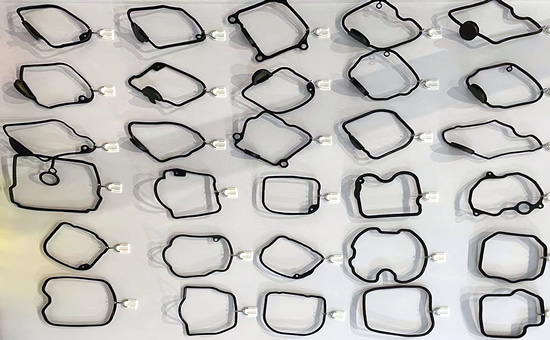Nitrile regenerated rubber has the characteristics of oil resistance, good thermal performance, high chemical stability, and low elastic coefficient, and is widely used in the production of O-type oil-resistant sealing rings. The hardness of 70-80 degrees, the sealing effect is obvious; it can work in the environment above 120°C for a long time, meeting the sealing needs under high temperature conditions; the size and shape are stable, the shape change is small during the initial installation and use, and the sealing effect is stable and lasting; Low cost, high cost performance; under normal conditions, the service life can reach 5-10 years, reducing maintenance and replacement frequency. Therefore, nitrile rubber is an ideal material choice for the production of O-rings. Its excellent vulcanization performance, high temperature chemical resistance and sealing performance make it fully meet the material requirements of O-ring products. It also has the advantages of long service life and low cost, and is favored and loved by customers.
Vulcanization formula for producing O-rings from nitrile regenerated rubber:
100 parts of regenerated nitrile rubber, 10 parts of N550 carbon black, 1.5 parts of accelerator CBS, 1.5 parts of accelerator DPG, 2.5 parts of sulfur, 1 part of vulcanization synergist, release agent 1-2 Serving
The vulcanization process of producing O-ring from nitrile regenerated rubber:
Preheating: around 160°C, 5-8min
Vulcanization: 155°C, t95% hardness, the specific vulcanization time is determined according to the size and thickness of the O-ring, and the Shore hardness after vulcanization is about 70-75 degrees

Precautions for producing O-rings from nitrile reclaimed rubber YYES522:
1. Nitrile reclaimed rubber is different from latex reclaimed rubber in that it vulcanizes faster, and the vulcanization time must be controlled accurately, otherwise it is easy to overvulcanize and cause the product to be too hard or damaged.
2. The vulcanization temperature is high and needs to be controlled accurately. If it is too high, the regenerated rubber will be polarized and lose its elasticity.
3. The amount of the accelerator is appropriate, too much will cause the vulcanization reaction to be too fast and cause polarity damage.
4. The amount of release agent should be appropriate, too little will not achieve a good release effect, too much will affect the surface quality of the product.
5. The cooling speed should be slow. The polarity of the regenerated nitrile rubber after vulcanization is weak, and cooling too fast will aggravate the embrittlement phenomenon.
6. During the vulcanization process, ensure that the sealing ring maintains its basic shape without deformation, otherwise it will affect the sealing performance.
The production of nitrile regenerated rubber O-ring seals requires precise control of vulcanization parameters and processes, focusing on vulcanization speed, temperature, accelerator dosage, cooling speed, etc. At the same time, attention must also be paid to product quality and dimensional accuracy to ensure product sealing performance. The production process should be standardized and refined, continuously optimized and improved to reduce quality differences and installation and sealing obstacles.
Exclusive original article [commercial authorization] reprint, excerpt and excerpt in any form are prohibited without written authorization. Focus on Hongyun rubber: learn the process formula and raw material technology of producing rubber products from recycled rubber to help you reduce costs and increase profits